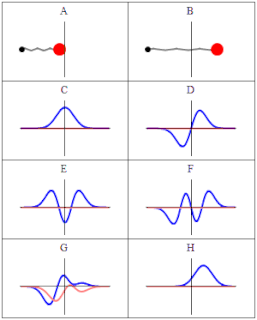In mathematics, the dimension of a vector space V is the cardinality of a basis of V over its base field. It is sometimes called Hamel dimension or algebraic dimension to distinguish it from other types of dimension.

The quantum harmonic oscillator is the quantum-mechanical analog of the classical harmonic oscillator. Because an arbitrary smooth potential can usually be approximated as a harmonic potential at the vicinity of a stable equilibrium point, it is one of the most important model systems in quantum mechanics. Furthermore, it is one of the few quantum-mechanical systems for which an exact, analytical solution is known.
In the field of representation theory in mathematics, a projective representation of a group G on a vector space V over a field F is a group homomorphism from G to the projective linear group
Superspace is the coordinate space of a theory exhibiting supersymmetry. In such a formulation, along with ordinary space dimensions x, y, z, ..., there are also "anticommuting" dimensions whose coordinates are labeled in Grassmann numbers rather than real numbers. The ordinary space dimensions correspond to bosonic degrees of freedom, the anticommuting dimensions to fermionic degrees of freedom.
In theoretical physics, a supermultiplet is a representation of a supersymmetry algebra.
Creation operators and annihilation operators are mathematical operators that have widespread applications in quantum mechanics, notably in the study of quantum harmonic oscillators and many-particle systems. An annihilation operator lowers the number of particles in a given state by one. A creation operator increases the number of particles in a given state by one, and it is the adjoint of the annihilation operator. In many subfields of physics and chemistry, the use of these operators instead of wavefunctions is known as second quantization. They were introduced by Paul Dirac.
In theoretical physics, a super-Poincaré algebra is an extension of the Poincaré algebra to incorporate supersymmetry, a relation between bosons and fermions. They are examples of supersymmetry algebras, and are Lie superalgebras. Thus a super-Poincaré algebra is a Z2-graded vector space with a graded Lie bracket such that the even part is a Lie algebra containing the Poincaré algebra, and the odd part is built from spinors on which there is an anticommutation relation with values in the even part.
In quantum mechanics, a parity transformation is the flip in the sign of one spatial coordinate. In three dimensions, it can also refer to the simultaneous flip in the sign of all three spatial coordinates :

In quantum mechanics, an energy level is degenerate if it corresponds to two or more different measurable states of a quantum system. Conversely, two or more different states of a quantum mechanical system are said to be degenerate if they give the same value of energy upon measurement. The number of different states corresponding to a particular energy level is known as the degree of degeneracy of the level. It is represented mathematically by the Hamiltonian for the system having more than one linearly independent eigenstate with the same energy eigenvalue. When this is the case, energy alone is not enough to characterize what state the system is in, and other quantum numbers are needed to characterize the exact state when distinction is desired. In classical mechanics, this can be understood in terms of different possible trajectories corresponding to the same energy.
In theoretical physics, a primary field, also called a primary operator, or simply a primary, is a local operator in a conformal field theory which is annihilated by the part of the conformal algebra consisting of the lowering generators. From the representation theory point of view, a primary is the lowest dimension operator in a given representation of the conformal algebra. All other operators in a representation are called descendants; they can be obtained by acting on the primary with the raising generators.
In physics, a charge is any of many different quantities, such as the electric charge in electromagnetism or the color charge in quantum chromodynamics. Charges correspond to the time-invariant generators of a symmetry group, and specifically, to the generators that commute with the Hamiltonian. Charges are often denoted by the letter Q, and so the invariance of the charge corresponds to the vanishing commutator , where H is the Hamiltonian. Thus, charges are associated with conserved quantum numbers; these are the eigenvalues q of the generator Q.
In theoretical physics a nonrenormalization theorem is a limitation on how a certain quantity in the classical description of a quantum field theory may be modified by renormalization in the full quantum theory. Renormalization theorems are common in theories with a sufficient amount of supersymmetry, usually at least 4 supercharges.
In theoretical physics, a supersymmetry algebra is a mathematical formalism for describing the relation between bosons and fermions. The supersymmetry algebra contains not only the Poincaré algebra and a compact subalgebra of internal symmetries, but also contains some fermionic supercharges, transforming as a sum of N real spinor representations of the Poincaré group. Such symmetries are allowed by the Haag–Łopuszański–Sohnius theorem. When N>1 the algebra is said to have extended supersymmetry. The supersymmetry algebra is a semidirect sum of a central extension of the super-Poincaré algebra by a compact Lie algebra B of internal symmetries.
Higher-dimensional supergravity is the supersymmetric generalization of general relativity in higher dimensions. Supergravity can be formulated in any number of dimensions up to eleven. This article focuses upon supergravity (SUGRA) in greater than four dimensions.
In theoretical physics, massive representations of an extended supersymmetry algebra called BPS states have mass equal to the supersymmetry central charge Z. Quantum mechanically, if the supersymmetry remains unbroken, exact equality to the modulus of Z exists. Their importance arises as the supermultiplets shorten for generic massive representations, with stability and mass formula exact.
This page is a glossary of terms in string theory, including related areas such as supergravity, supersymmetry, and high energy physics.
In mathematics and physics, super Minkowski space or Minkowski superspace is a supersymmetric extension of Minkowski space, sometimes used as the base manifold for superfields. It is acted on by the super Poincaré algebra.

Symmetries in quantum mechanics describe features of spacetime and particles which are unchanged under some transformation, in the context of quantum mechanics, relativistic quantum mechanics and quantum field theory, and with applications in the mathematical formulation of the standard model and condensed matter physics. In general, symmetry in physics, invariance, and conservation laws, are fundamentally important constraints for formulating physical theories and models. In practice, they are powerful methods for solving problems and predicting what can happen. While conservation laws do not always give the answer to the problem directly, they form the correct constraints and the first steps to solving a multitude of problems.
Supersymmetric theory of stochastic dynamics or stochastics (STS) is an exact theory of stochastic (partial) differential equations (SDEs), the class of mathematical models with the widest applicability covering, in particular, all continuous time dynamical systems, with and without noise. The main utility of the theory from the physical point of view is a rigorous theoretical explanation of the ubiquitous spontaneous long-range dynamical behavior that manifests itself across disciplines via such phenomena as 1/f, flicker, and crackling noises and the power-law statistics, or Zipf's law, of instantonic processes like earthquakes and neuroavalanches. From the mathematical point of view, STS is interesting because it bridges the two major parts of mathematical physics – the dynamical systems theory and topological field theories. Besides these and related disciplines such as algebraic topology and supersymmetric field theories, STS is also connected with the traditional theory of stochastic differential equations and the theory of pseudo-Hermitian operators.

In mathematics, the representation theory of semisimple Lie algebras is one of the crowning achievements of the theory of Lie groups and Lie algebras. The theory was worked out mainly by E. Cartan and H. Weyl and because of that, the theory is also known as the Cartan–Weyl theory. The theory gives the structural description and classification of a finite-dimensional representation of a semisimple Lie algebra ; in particular, it gives a way to parametrize irreducible finite-dimensional representations of a semisimple Lie algebra, the result known as the theorem of the highest weight.





